IAC News
IAC News No.25, November 2014
Japan Society of Civil Engineers International Activities Center Nov. 4, 2014 IAC News No.25
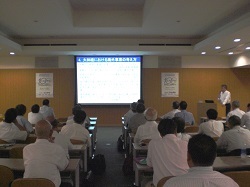 IAC Japanese Civil Engineers the Global Leaders Symposium Series No.2 |
Why does JSCE celebrate 100th Anniversary with our international friends?
JSCE celebrates the 100th Anniversary this year. JSCE was founded much later than other major societies in engineering, such as Architectural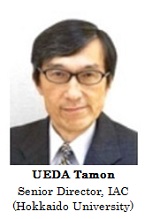 Institute of Japan. This was because civil engineering was considered as the core of engineering and stayed in The Japan Federation of Engineering Societies(JFES). Civil engineers in Japan made their best efforts to provide safe and comfortable living environments in Japan through the activities of JFES and JSCE. Now the nature of civil engineering is still the same. As you are aware, however, the issues have become global far beyond the border of Japan.
Institute of Japan. This was because civil engineering was considered as the core of engineering and stayed in The Japan Federation of Engineering Societies(JFES). Civil engineers in Japan made their best efforts to provide safe and comfortable living environments in Japan through the activities of JFES and JSCE. Now the nature of civil engineering is still the same. As you are aware, however, the issues have become global far beyond the border of Japan.
The occasion of JSCE 100th Anniversary is the precious opportunity to show the future direction of JSCE for the next 100 years. JSCE started the preparation for the anniversary events nearly a decade ago, which includes various international events as follows:
(1)International Forum on “Contributions of Infrastructure to Life of Affluence” on 20th November 2014
(2)International Workshop on Sustainability and Resilience of Infrastructures Based on Maintenance and Management on 20th November 2014
(3)3rd Roundtable Meeting on Disaster Management on 19th November 2014
(4)International Workshop for Young Civil Engineers on 10th – 13th September 2014
(5)Korea・Japan・Taiwan Joint Conference on Civil Engineering on 29th August 2014
The International Forum and International Workshop on 20th November would show civil engineers’ responsibility for coming years to make our life even better by the worldwide international collaboration. The International Roundtable Meeting would indicate the way on how to share the experiences for tackling common issue, especially among Asian communities to which JSCE belongs. International collaboration can be achieved even among chapters (sections) of the nationwide organizations, such as JSCE and KSCE. The Joint Conference was a good example. Every organization like JSCE needs more participation of young generation, especially to cope with challenging issues in the future. I believe that the International Workshop for Young Civil Engineers would be a model case for not only JSCE but also other similar organizations in the world.
On the occasion of 100th Anniversary JSCE should show the future direction, in which JSCE would take leading role worldwide as professional society in civil engineering. In 2012 JSCE established the International Activities Center. In the statement to explain the necessity of establishment of International Activities Center, a sentence reads, “JSCE is expecting that 50% of its activities would be related to international matters”. The 100th Anniversary International Events could be the starting point towards this expectation.
Every one of you is most welcome to join the international events on 19th and 20th November 2014 to witness the new start of JSCE for the coming 100 years.
Exhibition of International Workshop for Young Civil Engineers
International Workshop for Young Civil Engineers was held in JSCE Annual Conference (Toyonaka, Osaka), as one of the commemorative events of 100th Anniversary, by International Students Network Group and International Working Group of 100th Anniversary Commemorative Events from September 10th to 13th. Under the title of this workshop, “Facing the Challenges of Our Future Society”, participants predicted future society in 2050, and discussed about civil engineers’ own roles played at that time.
51 members took part in Workshop including 11 invitees from overseas, domestic foreign students, and engineers from companies and research institutes. Participants with 21 nationalities were divided into 9 groups by 5-6 people for each of them, analyzed main factors of evacuation of Kamaishi in the Great East Japan Earthquake by case method on the first day in an ice-break position. Group members gathered existing problems and their approaches to Post It, and organized the information of success factors of evacuation seen in young people by sorting them.
On the second day, each group did prediction by scanning materials based on the information about dozens of social change and technologies for foreseeing the future society. Society in 2050 was predicted by the information which was not only about civil engineering, but also concerned with things like information technology, genetic factors, intelligence, energy, climate, population, and happiness. Various of discussion were held within each group, and all of them had their future prediction after exchanging information by mid-term presentations. Eventually, participants summarized their own thought about his or her role as a civil engineer to a poster.
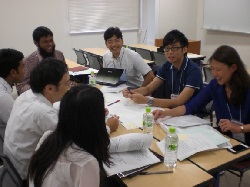 Group Discussion |
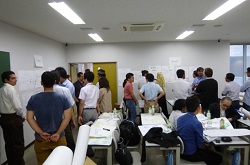 Poster Session |
The final presentation was held on the third day. Open Discussion on “Facing the Challenges of Our Future Society” was held as a part of Research Symposium of JSCE Annual Conference, where group presentation and discussions took place in public. Each presentation was responded with numbers of questions and discussions, leading the discussion to a lively event. On the other hand, Masahiko Isobe JSCE President, Tamon Ueda Senior Director of IAC gave greetings, as well as expectations and messages, both on opening and closing ceremony to the participants who also had their own 1-minute speech.
This kind of method, with which could help people to make prediction not simply based on work, research, or studies being worked on currently, but also having taken the trend of whole society into consideration, and then to think about their own role as a civil engineer from it, is doubtlessly a fresh way for all participants, especially young engineers, to whom it was also considered as a meaningful opportunity.
In the evening, participants who worked in Japanese companies introduced their work contents, so that invitees from overseas and foreign students could have chance to know about Japanese companies. Participants deepened their friendship with each other in closing party, while Dr. Yozo Fujino, Chairman of JSCE Executive Committee on 100th Anniversary Commemorative Events, and Mr. Katsuji Fukumoto former Director of IAC gave messages to all of them.
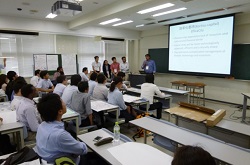 Research Symposium |
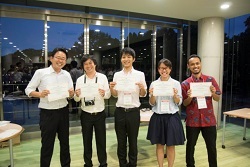 Closing Party |
On the last day, as a technical tour, participants visited Akashi Kaikyo Bridge, climbed the pylon, and experienced the longest span suspension bridge in the world. They also studied recovery of victim from the Great Hanshin Awaji Earthquake in Earthquake Museum.
This 4-day workshop involved more than 50 participants was the biggest event for foreign students till now. Active discussion, mutual stimulation, and deep communication among these participants with different background still made this event an appropriate one to International Workshop for Young Civil Engineers.
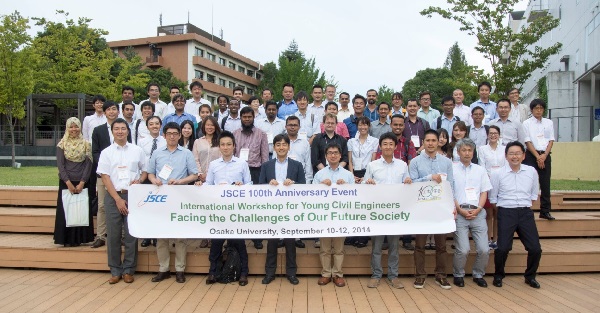 Entire Group |
Report for “The 8th Joint International Symposium on Disaster Risk Management --Education for Disaster Prevention, Reconstruction from Kobe Earthquake Disaster, and Adaptation plan under Climate Change–“
The engineering-related academic associations (the Architectural Institute of Japan, ‘AIJ’, the Japan Society of Civil Engineers, the Japan Federation of Engineering Societies) and the international non-governmental organization for engineers (the World Federation of Engineering Organizations, ‘WFEO’) held the 8th Joint International Symposium on Disaster Risk Management (DRM), in Kobe University (Kobe City, Japan), Sept. 13, 2014 during the AIJ 2014 annual meeting. The Science Council of Japan SCJ supported this symposium. The symposium committee invited eight guest speakers from Japan, Taiwan, India, Israel, Peru, and Colombia. They are remarkable researchers, educators and engineers, whose backgrounds are primarily education, engineering, and social science for worldwide or local disaster prevention and reduction.
According to the symposium program (program site), the AIJ President, Prof. Yoshino, had opening remarks and talked about robust preparedness for future severe disasters based upon the lessons from past disaster events. Four presentations and Q&A were performed sequentially in the first session: Introduction of severe natural disasters that India experienced by Er. Basa (President, Institution of Engineers, India), A case study of local community activities for disaster prevention by Prof. Liu (National Chinan Univ., Taiwan), Assessment for disaster management programs in Taiwan local governments by Prof. Mars (Ming Chuan Univ., Taiwan), Reconstruction process from the 1995 Kobe Earthquake Disaster and Example of disaster management and disaster prevention education in a Bangladesh community by Dr. Saito (Disaster Reduction and Human Renovation Institution, Japan), and finally Q&A for the first session. Then, the second session started after a short break. Four talks were presented: Lessons from the tsunami catastrophe in the Tohoku Earthquake for disaster reduction by Prof. Mas (Tohoku Univ., Japan); Research needs for efficient quick recovery from earthquake by Prof. Lavan (Technion-Israel Institute of Technology, Israel); Control of chemical pollution caused by natural disasters by Prof. Cruz (Kyoto Univ., Japan); and Architectural viewpoint in evacuation and reconstruction facilities by Prof. Furuya (Waseda Univ., Japan). Each session’s Q&A had meaningful discussions related to disaster prevention and reduction among the speakers and approximately 60 audience members. Finally, Prof. Komatsu (Chair, WFEO-Committee on DRM) performed closing remarks and the announcement for the World Engineering Conference and Convention 2015, which will be held in Kyoto City (Japan) for engineers all over the world.
The proceedings that the symposium committee published can be downloaded from http://www.wfeo.net/stc_disaster_risk_management_meetings/.
(Note) The WFEO (a professional group for engineering) has a world-wide mission to provide solutions for poverty problems and for sustainable development in stable social infrastructure and economics through appropriate technology and innovation; The Committee on DRM (CDRM) is a standing technical committee of the WFEO and working for disaster risk management; and Er is the honorific title of Engineer.
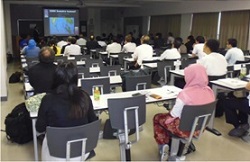 Audiences |
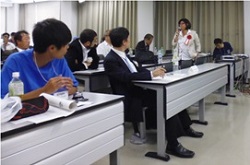 Q&A |
 Group photo |
JSCE UK Section Report
The JSCE UK section is a group of people who are associated with Civil Engineering based in UK. The President, Chairman of the Group is Professor Sogo of University of Cambridge and Mr Tsumura, the President of London Research International has a secretarial role. Although there are only three members who formally belong to the UK section, a number of Japanese engineers seconded to UK firms and research institutions, and exchange students studying at UK universities also take parts in regular meetings. The JSCE UK section is the only organisation for engineers and academics associated with Japanese Civil Engineering, providing information on UK Civil Engineering for visitors belonging to the JSCE.
Photo 1 shows a gathering on the occasion when Mr Kotaro Hashimoto, the immediate past president of the JSCE, visited London last year in order to invite the President of the Institution of Civil Engineers (ICE) to the JSCE 100th Anniversary commemorative event, which will be held later this year. We had a discussion on the difference between the JSCE and ICE and the future of the Japanese civil engineering industry.
Photo 2 shows a gathering on the occasion when Professor Fujino, the Chairman of JSCE Executive Committee on 100th Anniversary of JSCE, visited London in July. We had a discussion on the performance of UK engineering consulting firms and overseas activities of Japanese general contractors.
 Photo 1 Gathering on the Occasion of the JSCE President visit |
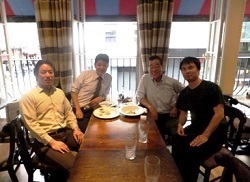 Photo 2 Gathering on the Occasion of the Professor Fujino visit to UK |
Well, who is writing this article? My name is Daisuke Saito, and I work for the company called Mott MacDonald, which is one of the major engineering consulting firms in the UK, being involved in projects associated with the design and assessment of civil engineering structures, mainly bridges. I have been a member of the JSCE UK section for the last 9 years. I am often disappointed with the fact that advanced engineering technologies which were developed by the Japanese Civil Engineering Industry are almost never known to engineers based in UK. I am hoping we can take some role in order to improve the situation in cooperation with the JSCE international activities centre. Please let the Headquarter of the JSCE know of your official visit to the UK and we look forward to welcoming you in UK.
What's Happening
●2014/11/13~15・・・・・PICE Annual Conference 2014 (City of Legazpi ,Philippines)
●2014/12/3・・・・・・JSCE-HCMUT Joint Seminar on Bridge Health Monitoring 2014
≪Topics of JSCE 100th Anniversary Event≫
●2014/11/19・・・・・・3rd Round Table Meeting on Disaster Management (JSCE HQ, Tokyo)
http://jsce100.com/node/248
●2014/11/20・・・・・・International Forum on “Contributions of Infrastructure to Life of Affluence”
(JP Tower Hal l& Conference, Tokyo) http://jsce100.com/node/249
●2014/11/20・・・・・・JAPAN SOCIETY OF CIVIL ENGINEERS 100th Anniversary International Workshop on Sustainability and Resilience of Infrastructures Based on Maintenance and Management Organized By Structural Engineering Committee, JSCE (JSCE HQ, Tokyo) http://www.jsce-int.org/node/289
●2014/12/3・・・・・・IAC Japanese Civil Engineers the Global Leaders Symposium Series No.3
Pahang-Selangor Raw Water Transfer Project
Updates
●The summary of feature articles in the JSCE Magazine is available on the JSCE website.
http://www.jsce-int.org/pub/magazine
●Concrete Committee International Newsletter No. 38
http://www.jsce.or.jp/committee/concrete/e/newsletter/Newsletter.htm
●Journal of JSCE
The Journal of JSCE is the collection of research papers which can be viewed on the JSCE website.
https://www.jstage.jst.go.jp/browse/journalofjsce
●JSCE 100th Anniversary Postal Stamp was released in September, 2014.
http://jsce100.com/node/250(Japanese Only)
IAC News Subscription
The IAC News is one of the communication tools to share information and ideas with the members. We would like to invite you, your friends and colleagues to join the communication and to subscribe the IAC News. Please register online: (http://www.jsce-int.org/pub/registration/non-international_students). We look forward to meeting you.
Editor's postscript
Japan Society of Civil Engineers was established in November 1914 and celebrates its 100th anniversary this month. For 100 years, it is great to have contributed to the progress of the civil engineering technology and social development. At the opening of the Tokyo Station 100 years ago, I think that nobody was able to imagine that the linear Chuo Shinkansen, running at over 500km/h is planned. What kind of future will it be 100 years 1ater? “Doraemon” is supposed to be born 100 years from now. We may be running around the sky with a flight tool such as Takekoputer. I want to support the development of such a bright future. (U.H)
